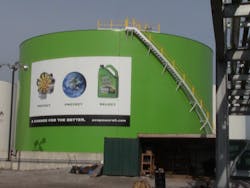There are a lot of misconceptions about re-refined motor oils and lubes. Today’s re-refining processes are considerably different, and much more advanced, then when re-refining first began during World War II when everything was in short supply.
To be honest, I never gave re-refined oil much consideration. When I came into the industry many years ago, I was taught to go with the “real” stuff.
Last week, I was invited by Safety-Kleen to tour its re-refinery in East Chicago, IN.
The company is a leading provider of environmental services to commercial, industrial and automotive customers, and the largest re-refiner of used oil and provider of parts cleaning services in North America.
Safety-Kleen owns and operates two oil re-refineries - the second one is in Breslau, Ontario, Canada. Together, the two re-refiners represent approximately 60 percent of the total oil re-refining capacity in North America, I was informed by Scott Miller, director of refining for the East Chicago facility, the largest oil re-refinery in North America.
Despite the size (the facility covers some 30 acres) and production volume, the facility has gone more than 3 million hours - more than 16 years - without a lost time accident. Impressive.
The tour opportunity, my first time at any kind of refinery, was an insightful and educational experience.
The largest
As the largest collector and re-refiner of used oil in North America, last year, Safety-Kleen collected approximately 200 million gallons of used oil, re-refining about 160 million gallons to produce high-quality base and blended lubricating oils.
The molecules in engine oil don't break down, it just gets dirty and the additives need to be refreshed, Mike Ebert, vice president of engineering and business development for Safety-Kleen, explained to me.
The company’s re-refining begins with the used oil that has been collected put through a special process that includes vacuum distillation and hydro-treating, he said. This removes contaminants, such as fuel, water, sulfur and dirt, from the used oil, leaving new base oil that is equal to or better than base oil made from crude.
After the base oil is re-refined, it is blended with a unique package of additives to help reduce oxidation and engine wear while protecting against viscosity and thermal breakdown, Ebert continued. The result is clean, high-quality engine oil that protects engines and the environment.
In June 2012, Safety-Kleen completed a new blending facility at its East Chicago re-refinery, allowing it to blend more of its own finished oil products in-house.
The refining process consumes up to 85 percent less energy that refining motor oil from crude oil, noted Miller. Plus, re-refined oil reduces greenhouse gas emissions by up to 81 percent, according to API.
Safety-Kleen’s re-refined EcoPower family of products - which are American Petroleum (API)-licensed and exceed all North American standards for engine protection - includes heavy duty diesel engine oils and synthetic blend passenger car motor oils.
Among the users of EcoPower are Ryder Transportation, Enterprise Holding, Veolia Transportation and NationaLease.
About the Author

